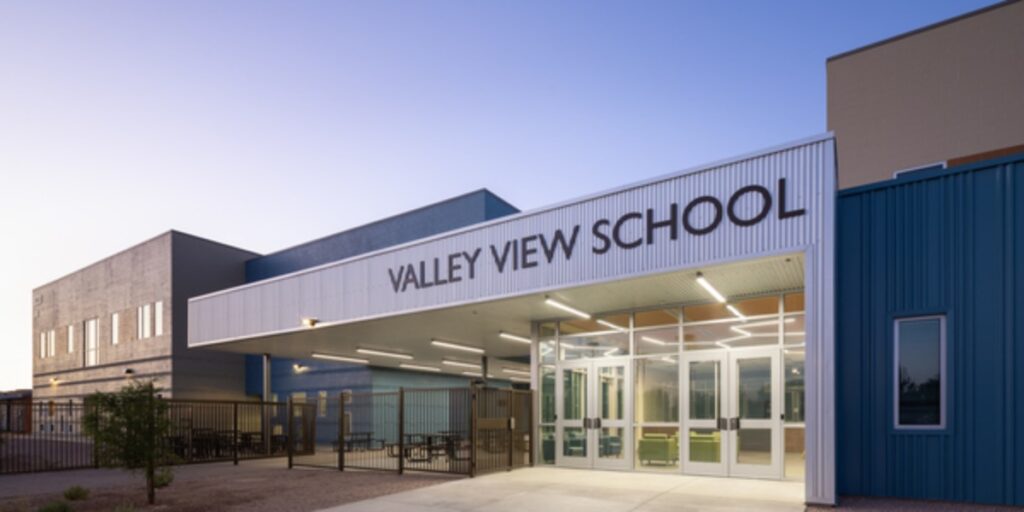 In this spotlight, we are honored to interview Arizona literacy educator Jessica Zimmerman. As the instructional coach at the K–8 Valley View Leadership Academy in Phoenix, Jessica shares how the school is closing the achievement gap using the SIPPS program. She also explains how a three-phase implementation plan has resulted in a sustained, school-wide Walk to Read intervention model.
In this spotlight, we are honored to interview Arizona literacy educator Jessica Zimmerman. As the instructional coach at the K–8 Valley View Leadership Academy in Phoenix, Jessica shares how the school is closing the achievement gap using the SIPPS program. She also explains how a three-phase implementation plan has resulted in a sustained, school-wide Walk to Read intervention model.
Tell us about yourself, your school and district, and the students that you serve.
My name is Jessica Zimmerman, and I’m a mom, educator, and creator. I graduated from Arizona State University with my master’s degree in Education.
I began my teaching in Roosevelt School District, where I taught in kindergarten–3rd grade. I eventually transitioned into teaching gifted and talented students in a resource teacher format.
In 2016, I was lucky enough to begin my adventure as an instructional coach at Valley View Leadership Academy, a K–8 school where I coach 35 phenomenal educators.

Roosevelt School District is a Title 1 community district in the heart of South Phoenix, Arizona. Roosevelt has always had a history of resiliency. Our parents, teachers, students, and staff come to work … and work they do! I have never seen commitment to education like I have seen here. Our teachers live, eat, and breathe a love of learning into everything they do.
Our K–8 students at Valley View are incredibly special. They are innovative, curious, and persistent. They have been through so much and yet they come to school excited to learn. They are truly the inspiration and the “why” behind everything we do.
Our K–8 students at Valley View are incredibly special. They are innovative, curious, and persistent. They have been through so much and yet they come to school excited to learn.
What is the most rewarding part of being an educator for you?
The most rewarding part of being an educator for me is seeing the lasting impact that teaching, coaching, and mentoring has on a student’s or teacher’s life.
When I work with someone, guide them through their thinking, set goals for improvement, provide support in finding strategies to be better, and then see them in action, using those strategies to be a better version of themselves—that is honestly why I love my job.
I get to see the lasting impact that educational resources have on development and success when they are aligned perfectly to learner needs. I also see the lasting impact that research-based strategies have on students who need something different, who need to learn in a way that makes sense to them.
I see the lasting impact that support, advocacy, mentoring, and relationships have on the whole human—building confidence with each conversation, lesson, and planning session.
I see the lasting impact that support, advocacy, mentoring, and relationships have on the whole human—building confidence with each conversation, lesson, and planning session.
Finally, I get to hear, even years later, that someone felt supported, understood, or special because of the work we did together. That is why I love my job and keep coming to do this work, every day.
How did Valley View become interested in SIPPS?
Our school initially became interested in SIPPS when I saw the program used during a summer school session a few years ago.
The growth I saw in the students receiving SIPPS instruction was just outstanding. I was blown away by the confidence the students had when leaving their SIPPS small groups.
So I spoke to the teacher who was teaching SIPPS. She was so positive about how easy, fun, and effective it was for the students that I had to learn more.
That’s when I reached out to Collaborative Classroom, and the local representative, Nancy Chalex, invited me and the team to a workshop held at a host school.
My resource teachers and I went to the workshop… and as soon as we left, we came to the consensus that SIPPS was something we HAD to do for our students in the Special Education program at Valley View.
Having learned about SIPPS, we finally had hope for closing the achievement gap; we could finally get some materials to our ESS special education teachers. They had been planning alone for years, trying to fill those reading foundational gaps, and at last here was a solution for us to try. We were ready to begin our SIPPS adventure.
The growth I saw in the students receiving SIPPS instruction was just outstanding. I was blown away by the confidence the students had when leaving their SIPPS small groups.
How long has your school been implementing SIPPS? Tell us about the phases of your implementation.
Here at Valley View, we have been implementing SIPPS now since 2017–2018.
In phase one, we began with our three resource teachers, using SIPPS as their Tier 2 curriculum with their identified special education students. They paired SIPPS with the students’ IEP goals, and the curriculum matched up perfectly with what the students were needing!
We saw so much growth from the students during this first year of SIPPS implementation. We knew we needed to expand the impact to our other students with foundational reading needs.
Next, we phased in SIPPS with our paraprofessionals for Tier 2 support during small-group reading time.
Our paraprofessionals provided SIPPS instruction to over 35 students in grades K–4 each trimester for the first two years of implementation (one being virtual instruction last year during the pandemic). The program is virtual-friendly, so we were able to continue the momentum of implementation, and it was exciting to see.
This year, 2021, is the year we took the big leap — call it phase three! With over 100 students already participating in the program and seeing growth, we chose SIPPS as our Tier 2 curriculum resource for our school-wide Walk to Read initiative.
With over 100 students already participating in the program and seeing growth, we chose SIPPS as our Tier 2 curriculum resource for our school-wide Walk to Read initiative.
That is so exciting! Tell us about Walk to Read.
In Walk to Read, four days per week, students (assessed and grouped by their SIPPS placement assessment) receive SIPPS instruction at their readiness level for 45 minutes per day.
We are currently in our first month of Walk to Read implementation and could not be happier with how it is going! We have grades 1–4 participating in SIPPS. In addition we have some SIPPS Challenge Level small groups for our grade 4–8 students who have severe instructional gaps.
We are so excited to see the growth the students will make and the impact this program will have on our school’s reading achievement. We couldn’t be more thrilled to continue our SIPPS adventure.
We will keep you updated and cannot wait to share the results SIPPS yields for Valley View students and teachers.
As an instructional coach, what do you appreciate about SIPPS? What do teachers appreciate about it?
Our teachers love how straightforward the SIPPS program is.
The scripting, the embedded teacher support (instructional videos on the Learning Portal along with the QR codes in the teacher’s manuals), and the instructional aides for students, like the story posters and the cards, are so well organized. Everything in the program supports teachers with implementation in such a meaningful way.
Nothing is done without purpose in SIPPS! The routines are golden, and my teachers have even told me that they have learned how to teach reading because of SIPPS.
As an instructional coach, I find SIPPS is far better than anything else I have seen at targeting foundational skills in a way students understand and master.
The program is streamlined: it moves sequentially from a primary entry point to adapting for the needs of older students who need developmentally appropriate foundational skills. This is key to a successful Tier 2 program.
I also appreciate how the Collaborative Classroom Learning Portal keeps expanding its offering of instructional resources and how easy it is to level students with the SIPPS Placement Assessments and Mastery Tests data.
I find SIPPS is far better than anything else I have seen at targeting foundational skills in a way students understand and master.
What have you noticed about students’ learning and engagement? What have teachers noticed?
I have noticed that students are excited to go into their SIPPS classes. They want to participate, and they are showing increased confidence in their reading skills as they build reading fluency and automaticity.
I see that our teachers are now able to support students in real time and encourage students through academic feedback.
In addition, teachers have noticed that the students do so well with the routines and structure, they know what to expect next! It’s really a brilliant program.
How has SIPPS shifted teaching practices and/or professional learning in your school?
SIPPS has shifted teaching practices in our school in so many ways!
I have seen our teachers get really good at seeing what students know based on using the instant academic feedback and correction structure embedded within SIPPS.
I have seen our teachers get really good at seeing what students know based on using the instant academic feedback and correction structure embedded within SIPPS.
I have also seen teachers utilizing placement data to inform instruction and set goals for students. Teachers have become fluent in foundational reading skills.
As our school has shifted in practice, it is now achievable to use the program at a school-wide level with Walk to Read to address foundational skills needs. That’s huge for us!
Before SIPPS, this was a missing piece in our efforts and structures to close the achievement gap. Now we cannot wait to see the kids flourish, thanks to this added layer of support.
Arizona is investing in accelerating early literacy in its budget and in legislation such as SB 1572. How do you see SIPPS aligning with Arizona’s push to implement effective, evidence-based literacy instruction?
Our team was thrilled to be provided with additional funding from the Arizona Early Literacy Grant.
Here at Valley View and across Arizona in general, we are seeing an influx of grade K–3 students with foundational reading gaps, much more than in years past.
Thanks to the AZ Early Literacy Grant, we have been able to use these funds to purchase additional SIPPS levels, schedule professional learning, provide additional consumables for student use, as well as expand our reading libraries.
I have seen our teachers get really good at seeing what students know based on using the instant academic feedback and correction structure embedded within SIPPS.
Finally, what insights would you share with a fellow Arizona school or district that is considering SIPPS?
I would say: do it and implement the program in phases.
By implementing SIPPS in three phases, we were able to work out the kinks that come with adopting any new program. We were able to afford it with budgeting. Finally, we were able to build teacher capacity, get buy-in, and achieve sustainability of practices.
The “go slow to go fast” motto worked here at Valley View! I wouldn’t have done it any differently.
***
Related Resources
On-Demand Webinar: A “Walk to Read” Case Study: Breaking Free of Whole-Class Foundational Skills Instruction
Learn why so many states are recommending SIPPS.
Explore the research and evidence base for the SIPPS program.
